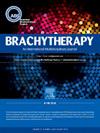明确接受Pd-103 LDR前列腺近距离治疗的患者的性功能和与邻近神经血管亚结构的剂量学关系
IF 1.8
4区 医学
Q4 ONCOLOGY
引用次数: 0
摘要
目的:报告Pd-103前列腺近距离治疗与性健康的相关结果,并评估其对附近神经血管结构的剂量学模式。在一项确定接受Pd-103 LDR近距离治疗的机构队列中,评估神经血管亚结构剂量与勃起功能结局之间的潜在关系。材料和方法:本研究使用了一个经irb批准的数据库,其中包括2014年至2019年在我所接受低剂量率(LDR)前列腺近距离放射治疗的男性,用于前列腺癌的最终治疗。患者在会诊和随后的随访中例行完成生活质量问卷。与性毒性相关的结果数据是根据性健康调查问卷(SHIM)进行评估的。先前存在勃起功能障碍的患者(SHIM)结果:约62例患者符合标准并被纳入分析。所有患者在诊断时均为极低、低、有利的中度或不利的中度疾病。中位随访时间为5.5年,共完成380份个人问卷;58例(93.5%)患者随访时间超过2年,28例(45.2%)患者随访时间超过5年。平均基线SHIM信心评分为4.0 (SD 0.9)。在最近的随访中,34名患者(53%)的SHIM信心评分大于或等于3。治疗后,该队列的平均置信度SHIM从4下降到3,并没有随着时间的推移回到基线。在6个月、2年、4年和5年时间点,高剂量NVB组表现出更差的SHIM评分。在5年随访中,高剂量组的平均SHIM置信度为2.2 ± 1.3,低剂量组为3.6 ± 1.3。结论:LDR Pd-103种子前列腺近距离治疗后,勃起功能似乎有所下降,手术后SHIM评分从基线下降到手术前评分。Pd-103 LDR前列腺近距离治疗对邻近神经血管亚结构(非NVBs)的剂量极低,不太可能是与这种治疗方式相关的性功能下降的主要原因。在单个亚结构中,NVB剂量可能是最关键的。本文章由计算机程序翻译,如有差异,请以英文原文为准。
Sexual function and dosimetric relationships to neighboring neurovascular substructures among patients treated definitively with Pd-103 LDR prostate brachytherapy
PURPOSE
To report sexual health outcomes related to Pd-103 prostate brachytherapy and evaluate dosimetric patterns to the nearby neurovascular structures. To assess potential relationships between dose to neurovascular substructures and erectile function outcomes in an institutional cohort treated definitively with Pd-103 LDR brachytherapy.
MATERIALS AND METHODS
The study utilized an IRB-approved database of men receiving low dose rate (LDR) prostate brachytherapy from 2014 to 2019 at our institution for definitive prostate cancer treatment. Patients routinely completed quality of life questionnaires at consultation and at subsequent follow up visits. Outcomes data related to sexual toxicity were evaluated based on the Sexual Health Inventory (SHIM) Questionnaire. Patients with pre-existing erectile dysfunction (SHIM <17 or SHIM confidence score <3) were excluded. The pudendal arteries, neurovascular bundles, subapical region, and penile bulb, were contoured on postimplant imaging and dosimetric data was analyzed. For all statistical comparisons, a student’s t-test was used with alpha of 0.05 indicating significance.
RESULTS
About 62 patients met criteria and were included in the analysis. All patients had either very low, low, favorable intermediate or unfavorable intermediate disease at diagnosis. Median follow-up was 5.5 years with total 380 individual questionnaires completed; 58 (93.5%) patients had follow-up greater than 2 years, and 28 (45.2%) patients had follow-up longer than 5 years. Mean baseline SHIM confidence score was 4.0 (SD 0.9). At most recent follow up, 34 patients (53%) had a SHIM confidence score greater than or equal to 3. Mean confidence SHIM for the cohort decreased from 4 to 3 after treatment and did not return to baseline over time. At the 6-month, 2-year, 4-year, and 5-year time points, the high dose NVB cohort demonstrated worse SHIM scores. At 5-year follow up, mean SHIM confidence was 2.2 ± 1.3 for the high dose group versus 3.6 ± 1.3 in the low dose group.
CONCLUSIONS
Erectile function appears to decrease following prostate brachytherapy with LDR Pd-103 seeds, demonstrated by a reduction in post procedural SHIM scores from baseline without recovery to preprocedure scores. The dose to adjacent neurovascular substructures other than NVBs is exceedingly low following Pd-103 LDR prostate brachytherapy and is unlikely to be the primary contributor to decreased sexual function related to this treatment modality. Out of the individual substructures, NVB dose may be the most critical.
求助全文
通过发布文献求助,成功后即可免费获取论文全文。
去求助
来源期刊

Brachytherapy
医学-核医学
CiteScore
3.40
自引率
21.10%
发文量
119
审稿时长
9.1 weeks
期刊介绍:
Brachytherapy is an international and multidisciplinary journal that publishes original peer-reviewed articles and selected reviews on the techniques and clinical applications of interstitial and intracavitary radiation in the management of cancers. Laboratory and experimental research relevant to clinical practice is also included. Related disciplines include medical physics, medical oncology, and radiation oncology and radiology. Brachytherapy publishes technical advances, original articles, reviews, and point/counterpoint on controversial issues. Original articles that address any aspect of brachytherapy are invited. Letters to the Editor-in-Chief are encouraged.
 求助内容:
求助内容: 应助结果提醒方式:
应助结果提醒方式:


